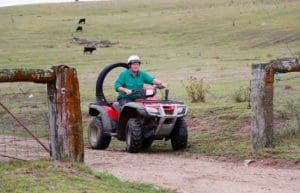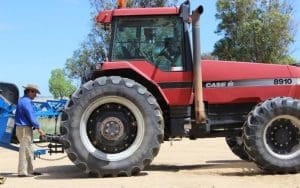
INDUSTRY groups and governments are reminding farmers to be vigilant about their safety practices as part of National Farm Safety Week.
National Farm Safety Week is running from July 21-26 with the theme “Innovative, Safe and Healthy”.
Farms remain among the most dangerous workplaces in Australia.
In 2017, there were 68 on-farm fatalities, nine of those involving a child aged under 15 years, and another 179 non-fatal on-farm injuries were recorded.
Tractors and quads bikes were the leading causes of on-farm fatalities. Between 2001 and 2017, there were over 247 quad bike deaths.
In 2017 alone, there were 12 fatal incidents involving quad bikes with 11 occurring on-farm.
Farmsafe Australia chairman, Charles Armstrong, said although there had been an overall reduction of around 60 percent in the number of farm injuries and deaths over the past two decades, there was still much that needed to be done to reduce the incidence.
Mr Armstrong said during the week, Farmsafe Australia would be focusing on innovative ideas and practices to promote a safety culture on Australian farms, including the use of newfound technologies.
“In a time of technological transformation in workplaces, farming too is undergoing a period of exciting technological change as we move into the digital landscape.
“With this comes a remarkable opportunity for innovative solutions and ideas around farm safety,” he said.
“From digitised safety inductions using QR codes, to design improvements that make farm vehicles safer to operate, through to Personal Locator Beacons that sends a safety alert where something goes wrong in areas with no mobile reception, the possibilities are endless.
“Innovation can complement practical steps for farm safety. When you are out on the farm, it is important to let people know where you are going and what time you expect to be back so that someone can come looking for you if you are injured,” he said.
“Devices that automate safety alerts when something goes wrong, such as a quad bike rollover, can be the difference between help arriving on time, or too late.”
Quad bike statistics alarming
 Mr Armstrong said over half the 247 quad bike deaths from 2001 to 2007 resulted from machines rolling over, with riders being asphyxiated or crushed to death.
Mr Armstrong said over half the 247 quad bike deaths from 2001 to 2007 resulted from machines rolling over, with riders being asphyxiated or crushed to death.
“Farmsafe Australia has welcomed the recent ACCC review into quad bike safety and supports Option 5 of the draft recommendations which will, among other things, introduce a safety star rating system, mandate CPD’s on new bikes sold in Australia and introduce minimum test requirements for static stability, mechanical suspension and dynamic handling,” he said.
“These measures will have a real impact on the safe design of quad bikes.”
Mr Armstrong said quad bikes had an illusion of stability and people often thought that four wheels were safer than two wheels, but that wasn’t the case.
“Because of their instability, quads are often not the best or safest vehicle for the jobs that need to be undertaken on the farm,” he said.
“In many cases a small ute, side-by-side vehicle or two-wheel motorbike will be a better alternative and while these carry their own risks, we know they are lower than that of quads. In fact, many farmers have moved away from using quads at all because the risk of rollover is too high.”
Mr Armstrong said if using a quad, a key to reducing the number of deaths from rollovers was fitting a suitably tested crush protection device (CPD).
“The available evidence strongly supports the use of these devices. These devices will limit people being crushed by quads when they do rollover,” he said.
Victoria and NSW now offer a rebate program to encourage the fitting of CPDs to bikes currently in use, which are lightweight, can be simply fitted to most bikes and don’t interfere with normal riding practices.
The National Farmers Federation said being aware of the ways things can go pear-shaped and having strategies in place to mitigate the danger to yourself and others is always the smarter way to farm.
The federation said interested farmers can follow its updates here on AustralianFarmers, via the NFF Twitter feed, or through NFF partners on Twitter and Facebook.
Safe Ag Systems tips for positive actions
Safe Ag Systems is using National Farm Safety Week to focus on the positive aspects of farm safety, to promote actions farmers can take to improve their own safety culture.
Safe Ag Systems will publish case studies of everyday farm safety heroes designed to encourage farmers to view things on their own farms from a slightly different perspective.
These will be emailed directly to clients but will also feature on a dedicated section of the Safe Ag Systems website, as well as on its Facebook, Twitter and LinkedIn channels, which will host a suite of handy hints and fact sheets in coming months.
Practical steps that farmers can take to improve safety include:
- Having a safety plan in place that identifies potential hazards and taking specific actions to fix these.
- Always be on the look-out for new hazards and fixing these as soon as possible once identified.
- Setting clear safety procedures for risky work.
- Making sure everyone that works on the farm, including contractors understands and uses the safety procedures you have for your farm.
- Having an emergency plan in place in case there are any incident
Quad bikes are leading cause of child fatalities on farms
Mr Armstrong said farmers needed to take steps to protect children on farms by creating safe areas for them to play and keeping them away from hazardous pursuits.
Quad bikes were the leading cause of child fatalities on farms last year, while farm infrastructure such as water tanks and farm vehicles such as trucks and tractors were also causes.
“We are pleading with parents to ensure that children under 16 years don’t ride or be carried as passengers on quads of any size,” he said.
“The two things you can do straight away for young children that may live or visit your farm is to make sure you have a secure safe play area and not to allow children on quads.
“This may not make you popular but nobody likes to see children in these incidents, so let’s fix these issues for everyone.”
Tractors and machinery are leading farm fatality causes in Victoria

Victoria’s Minister for Agriculture Jaclyn Symes said the government was working closely with farmers and industry groups to make sure the message of farm safety is a priority.
“Nobody is more aware of the risks on farms than farmers themselves, and it’s crucial that they take care and follow safety processes to avoid a tragedy.”
Five people died as a result of workplace incidents on Victorian farms in the 2018-19 financial year, which tragically included two children. Another life was lost just days into the new financial year when a 59-year old man died in hospital following an incident felling trees on a property at Buxton.
Farm safety is a focus for WorkSafe Victoria, with the watchdog conducting more than 2700 farm inspections in the last financial year.
Incidents involving tractors and other machinery were the leading cause of workplace deaths on Victorian farms in 2018-19, prompting renewed calls for farmers to carry out rigorous safety checks and risk assessments. Farmers are also being urged to always ensure they wear seat belts, and to never hop on or off moving machinery.
WorkSafe is using National Farm Safety Week to educate farmers on the steps they can take to be safe while working alone, like ensuring they have a means of communication or a process for having someone check on them.
Further information can be found at: www.farmsafe.org.au or by contacting Farmsafe Australia on (02) 6269 5622, at [email protected] , or through your state Farmsafe group.



HAVE YOUR SAY